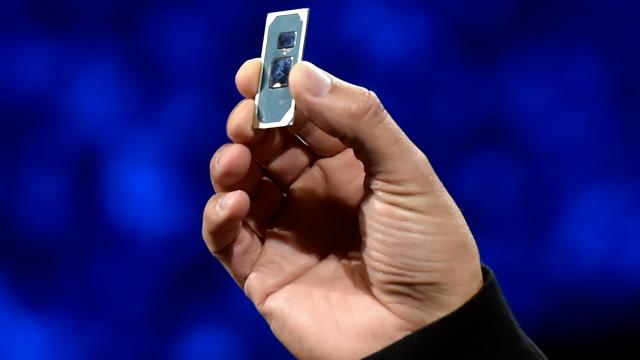AMD may have gotten its 7nm tech down, but according to Intel, AMD’s new Ryzen 9 4900H and 4900HS mobile processors are no match for its older 14nm tech. Today, Intel announced the arrival of its high-end 10th-gen mobile CPUs. Intel is still coasting on its 14nm tech with these new processors but the company says that it’s made the “first mobile processors to hit speeds of 5Ghz and over.”
Hot off the wafer-line are four new mobile processors, which include three Core i7s that have a boost clock speed of 5.0 GHz or higher, and one Core i9 that has a boost clock speed of 5.3 GHz. All have a thermal design power (TDP) of 45W, support two-channel DDR4 memory up to 2933 MHz, and are compatible with Intel Thermal Velocity Boost and Intel Optane Memory. Only the i9 and one of the i7s will have 8-cores/16-threads though.
[referenced url=” thumb=” title=” excerpt=”]
Those boost clock speeds are made possible through software tweaking, specifically Intel’s Turbo Boost Max and Thermal Velocity Boost technologies. Turbo Boost Max identifies the ‘better’ CPU cores that are stable at higher frequencies and boosts their speeds. (Not are cores are made alike, even if they come from the same wafer. AMD uses a similar tech, called Turbo, in its processors, too.) Thermal Velocity Boost works on top of Turbo Boost Max to also increase the processor’s clock frequency. According to Intel, it “opportunistically and automatically increases clock frequency by up to 200 MHz if the processor temperature is 65 degrees Celsius or lower and turbo power budget is available.” That means it doesn’t always sustain higher clocks and will drop once the cores go over the temperature threshold. But using the two technologies in tandem should help produce higher and reliable frequencies.
Of course, there’s no guarantee any of these new processors will hit those boost clocks. Turbo Boost Max and Thermal Velocity Boost will help, along with some good old-fashioned overclocking, but only one of Intel’s latest mobile processors will be totally unlocked—the Core i9-10980HK, which makes sense since it’s the highest-end mobile processor, but there isn’t an ‘H’ version, a partially unlocked CPU, as there was in the previous 9th generation. Instead, the middle 6-core/12-thread Core i7 is partially unlocked. What the heck does it mean to be partially unlocked, anyway?
While Turbo Boost Max and Thermal Velocity Boost are like temporary overclocks, having a CPU fully unlocked means you can overclock one or all cores to consistently run at a higher frequency. If you have a partially unlocked CPU, that means the OEM can set the frequency higher if they want, but it will vary by device, and the OEM might not even say if they did do that or not. With Intel’s 9th-gen mobile processors, OEMs could set the partially clocked CPUs up to 400 MHz higher than the boost clock, which would mean that a Core i7-9850H could theoretically reach up to 5.0 GHz. If OEMs choose do that this time around with the Core i7-10850H, they might be able to reach up to 5.5 GHz. Again, this will extremely dependent on the individual laptop. Your thinner and smaller laptops probably won’t be capable of overclocking like that as they’ll get too hot too quickly.
Keeping all that in mind, it seems like Intel is working hard to retain the title of ‘best computer processors,’ but that doesn’t mean AMD’s Ryzen 9 4000-series are something to overlook. They do have lower boost clocks, but higher base clocks, and they are faster than Intel’s Core i9 9th-gen mobile processors. (PC World has a nice, synthetic benchmark breakdown, if benchmarks are your thing.) If you want something faster at an equal or slightly lower price, AMD is the way to go. However, Intel seems one step ahead with its high-end 10th-gen mobile CPUs. Hopefully we’ll get our hands on some laptops to test soon.
